Dutch fighting the French revolutionary armies
1792-1795: The Dutch Republic
INFANTRY
There were National (Dutch), Walloon and Swiss troops. Contracts were signed with a few German rulers and foreign battalions and regiments were hired in Germany during 1792-1795. When the war broke out, French émigré units were also taken into Dutch service and new light units (National, German and émigré) were created.
Skirmishers were provided by separate light infantry units as the line infantry did not have a skirmisher detachment.
In 1795 the existing regiments or corps were either disbanded orreorganized to form the army of the Batavian Republic.
In 1792 Regimental Organisation comprised:
RegimentHollandse Garde – 2 battalions each of 1 grenadier (74 men) & 6 musketeercompanies (each of 67 men). 32 menregimental staff.
RegimentZwitserse Garde – 1 battalion of 8 musketeer companies (each of 150 men). 8 menregimental staff.
Garde Walen battalion – 1 grenadier (58 men) & 6 musketeercompanies (each of 53 men). 6 menregimental staff.
Line infantry Regiments – 2 battalions each of 1 grenadier (58men) & 6 musketeer companies (each of 53 men). 10 men regimental staff.
Swiss Regiments – 2 battalions each of 6 musketeer companies (eachof 100 men).
8 men regimental staff. Grenadier numbers unknown – they were partof each musketeer companies.
Jagers van Bijlandt battalion – 1 grenadier (58 men) & 4Musketeer/Jager companies (each of 80 men). 5 men regimental staff.
Garde Friesland – 1 company (202 men)
Garde Groningen – 1 company (75 men)
In 1793 almost all companies were subject to Augmentation following agreement to the Prince of Orange’s proposal to increase numbers as the army wasunder strength. Most companies received15 to 18 men although the Swiss received 50 men per company, while the staff ofline regiments received 5 musicians. The Hollandse Garde Regiment received 96 men and the Jagers van Bijlandt received18 men but I haven’t found how they were distributed.
Following Augmentation Regiments were organised as follows:
Regiment Hollandse Garde – 2 battalions each of 1 grenadier (74 men) & 6 musketeer companies (each of 75 men). 32 men regimental staff.(troop distribution suggested by aldegarde website but highly conjectural).
Regiment Zwitserse Garde – 1 battalions of 8 musketeer companies(each of 200 men). 8 men HQ.
Garde Walen battalion – 1 grenadier (76 men) & 6 musketeer companies (each of 68 men). 11men regimental staff.
Line infantry Regiments – 2 battalions each of 1 grenadier (76 men) & 6 musketeer companies (each of 68 men). 15 men regimental staff.
Swiss Regiments comprised 2 battalions each of 1 grenadier (76 men) & 6 musketeer companies (each of 68 men). 8 men regimental staff. Grenadiers were incorporated into musketeer companies but the number is notknown.
Jagers van Bijlandt battalion of 1 grenadier (60 men) & 4 musketeer companies (each of 84 men). 5 men regimental staff. (troop distribution suggested by aldegarde website but highly conjectural).
5e bataljon Waldeck battalion of 1 grenadier (76 men) & 6 musketeer companies (each of 68 men). 11 men regimental staff.
In practice strengths were far less, for example regiments with 12 musketeer companies fielded a battalion of 8 companies in 1793 or just 6 companies in 1794/95 – the remaining companies in each regiment were formed into a weak depot battalion.
Although numbered from 1772 regiments were still called by their owners’ name (the numbered Regiments below are also shown by some sources as Regiment Nationalen nr ?? owner’s name for example Regiment Nationalen nr1 de Schepper)
Regiment Oranje Nassau nr 1
Regiment Oranje Nassau nr 2
(2e bataljon became 1e bataljon Regiment Baden, later a new 2ebataljon was raised)
Regiment Erfprins van Oranje
Regiment Oranje-Gelderland
Regiment Oranje-Vriesland
Regiment Oranje-Stad en Land en Drenthe (usually referred to as Regiment Oranje-Stad en Land)
Regiment infanterie nr 1 de Schepper
Regiment infanterie nr 2 van Maneil
Regiment infanterie nr 3 van Dopff
Regiment infanterie nr 4 d’Envie
March 1794 became van Wilcke
Regiment infanterie nr 5 Pallardy
July 1791 became des Villattes
Regiment infanterie nr 6 van Welderen
Regiment infanterie nr 7 Hardenbroek
August 1791 became de Bons
Regiment infanterie nr 8 Onderwater
May 1790 becameBosc de la Calmette
Regiment infanterie nr 9 van Sommerlatte
October 1790 became van Randwijk
Regiment infanterie nr 10 van Brakel
Regiment infanterie nr 11 van Efferen
October 1798 becamevan Dam
Disbanded April1793 (1e bataljon became 2e bataljon Regiment van Baden; 2e bataljon became 2e bataljon Jagers van Bijlandt)
Regiment infanterie nr 12 van Bijlandt
September 1789 became Bedaulx
Regiment infanterie nr 13 Quadt van Huchtenbroek
May 1794 becamede Thouars
Regiment infanterie nr 14 Hessen-Darmstadt
Regiment infanterie nr 15 de Mallebois
December 1791 becamede Petit
Regiment infanterie nr 16 van Mönster
Regiment infanterie nr 17 van Plettenberg
Regiment infanterie nr 18 van Pabst
April 1793 became van Wartensleben
Regiment infanterie nr 19 Douglas (Regiment Mariniers)
Regiment infanterie nr 20 van Baden Durlach
December 1793 became von Wiguer
January 1794 Von Geusau
Regiment infanterie nr 21 van Westerloo (Regiment Mariniers)
Regiment infanterie nr 22 van Nijvenheim
Regiment infanterie nr 23 Stuart
Regiment infanterie nr 24 Dundas
December 1789 became Bentinck
Guard Infantry
Regiment Hollandse Gardes disbanded July 1795
Regiment Zwitserse Gardes disbanded July 1795
Bataljon Garde Walen (also known as Bataljon Walen de Perez)
GardeFriesland these were not combat troops.
Garde Groningen these were not combat troops.
German Regiments
Regiment Markgraaf van Baden formed April1793
(1e battalion formerly 2e bataljon Regiment Oranje-Nassau nr 2, 2e battalion formerly 1e bataljon Regiment Infanterie van Dam nr 11).
1e Regiment Vorst van Waldeck
2e Regiment Vorst van Waldeck
Regiment van Saksen-Gotha
Regiment Walen
October 1790 became Nassau-Usingen
Swiss Regiments
Regiment Zwitsers Nr 1 Hirzel
June 1794 became Lochman
Regiment Zwitsers Nr 2 Stockar de Neuform
Regiment Zwitsers Nr 3 Goumoëns
Regiment Zwitsers Nr 4 Schmid
Regiment Zwitsers Nr 5 May
Grenadier Battalions
Grenadier companies were formed into separate combined grenadierbattalions which took the name of their commanding officer.
For the 1793 campaign the battalions consisted mainly of 8 companies (drawn from 4 regiments); some consisted of 6 companies (drawn from of 3 or 4 regiments). They were named and organised (2 companies from contributing regiments unless otherwise indicated) as follows:
BataljonVan Raesfeldt = Douglas/ Van Maneil/ Bentinck/ des Vilates
BataljonVon Buseck = Van Dopf/ Van Brakel/ De Thouars/ NassauUsingen
BataljonVan Breydenbach = Oranje Gelderland/ Oranje Vriesland/Oranje Stad en Lande en Drenthe/ Van Plettenberg
Bataljonvan Zillnhardt = van Randwijk/ 1e Waldeck/ 2e Waldeck/Hessen-Darmstadt
BataljonVan Plettenberg = Bedaulx/ van Welderen/ Van Nijvenheim/ DeSchepper
Bataljonvan Tengnagell = Bosc de la Calmette/ Von Wartensleben/Westerloo/ van Baden
September1793 became Bataljon Prins van Reusz
BataljonVan Rechteren (6 companies) = Stuart/ Von Mönster/ De Bons
Bataljonde Larrey (6 companies) = 1e Oranje Nassau/ 2e OranjeNassau (1 comp)/ Erfprins/ Markgraaf van Baden (1 comp)
Bataljonvan Hohenlohe (6 companies) = De Petit/ Saxen-Gotha/ vonWilcke
Forthe 1794/95 campaign battalions had just 6 companies. They were named and organised as follows:
BataljonVan Raesfeldt = Douglas/ Van Maneil/ Bentinck
BataljonVon Buseck = Van Dopf/ Van Brakel/ De Thouars
BataljonVan Dongen = Oranje Gelderland/ Oranje Vriesland/ OranjeStad en Lande en Drenthe
BataljonMollenbruyn = Nassau-Usingen/ Markgraaf van Baden/ VanPlettenberg
BataljonVan Plettenberg = Bedaulx/ Van Nijvenheim/ De Schepper
BataljonPrins van Reusz = Von Geusau/ Von Wartensleben/ Westerloo
BataljonPrins van Hessen-Philipsthal = Van Welderen/ Bosc de laCalmette/ Des Vilattes
BataljonVan Panhuijs = Stuart/ Von Mönster/ De Bons
Bataljonde Larrey = Oranje Nassau nr 1/ Oranje Nassau nr 2/Erfprins
January1794 became Bataljon Van Solms
LIGHTINFANTRY
The light infantry consisted of National (Dutch) and foreign(mostly French emigré or German) troops.
Jagers van het Legioen Rijngraaf von Salm (or “Legioen Rijngraaf von Salm”)
April 1793 became 1e bataljon Jagers van Bijlandt)
Korps Jagers van Bijlandt raised April1793
1e bataljon from Jagers van Legioen Rijgraaf von Salm,
2e bataljonfrom 2e bataljon Regiment Infanterie nr 11 van Dam
Korps Jagers van Matthieu raisedJanuary 1794
June 1794 became von Heijdte
5e Bataljon Vorst von Waldeck recalled at beginning of 1793 from Waldeck, Germany where it hadbeen on half pay.
SUBSIDY TROOPS
German Capitulatie Troops:
TheUnited Provinces hired units from German Princes. Some were already in the service of the United Provinces before the outbreak of war, others were added following the outbreak of the war. They consisted mostly of line infantry with a light infantry component and sometimes added artillery and/or cavalry. The treaty with these Princes was called ” Capitulatie”.
Anspachse brigade (or “korpsAnspachse troepen”)
Capitulatie with Markgraaf van Brandenburg-Anspach March1788 to July1794 (end of contract)
Reitzenstein Fusilier battalion (5 companies)
Grenadier bataljon Beust (4 companies)
Waldenfels Jäger batalhon (2 companies)
1 company artillery
Mecklenburgse brigade (or”korps Mecklenburgse troepen”)
Capitulatie with Frederik Frans Herzog van Mecklenburg-Schwerin May 1788 to January 1796 (end of contract)
Grenadier Bataljon Winter (4 companies)
Pressentin Musketeers (2 musketeer battalions each 4 companies)
Brunswijckse brigade (or”korps Brunswijckse troepen”)
Capitulatie with Hertog vanBrunswijck February 1788 to 1794 end of contract
1 Dragoon regiment (4 companies)
Grenadier bataljon Prinz Friederich (4 companies)
Riedesel Musketeers (2 infantry regiments – each 2 battalions of 5 companies)
1 Jäger company
4 companies artillery
Regiment Sayn-Wittgenstein-Berleburg
Capitulatie with Sayn-Wittgenstein-Berleburg July 1794 to July 1795 (end of contract)
2 battalions each of 1grenadier and 6 musketeer companies
Regiment Hohenlohe-Bartenstein
Capitulatie with Hohenlohe-Bartenstein May 1794 to July 1795 (end of contract)
2 battalions each of 1 grenadier and 6 musketeer companies
Bataljon Jagers van Loewenstein-Wertheim
Capitulatie with the Duke of Bavaria May 1794 to July 1795 (end of contract)
Battalion of 5 companies
August 1794 – 6 companies
November 1794 – 7 companies
Emigré Units:
As the war progressed the United Provinces raised troops or contracted French nobles who had raised troops to fight against the “rebels”. The emigré units were mostly called “legioen” or “korps”(legions) because they consisted mostly of light and/or line infantry and cavalry, sometimes with an artillery detachment.
Korps van Béon
Capitulatie with F.F. de Béarn, count of Béon May 1793 to February1795 (end of contract)
4 light infantry companies
2 jägers companies (2 Jager companies of the korps of Rohan addedon 14 January 1794)
2 light dragoon companies.
Korps van de Prins van Rohan (also called “Vrijkorps van de Lega”)
Capitulatie with Prince de Rohan July 1794 to May1795 (end of contract)
2 jäger companies
2 sharpshooter companies
1 mounted jäger company.
An earlier corps with the same name existed but was disbanded.
January 1794 – 2 jäger companies went to the Korps of Beon and 2companies of light cavalry to the Korps of Damas
Korps van Damas
Capitulatie with C.E. Markgraaf van Damas May 1793 to February 1795 (end of contract)
2 jäger companies
4 light infantry companies f
January 1794 strengthened with 2 light dragoon companies from Korps van de Prins van Rohan
Vrijkorps van de Graaf van Luningen (also called “Vrijkorps van Luninck”)
Capitulatie met de Graaf van Luningen August 1794 to May 1795 (end of contract)
2 jäger companies
1 grenadier company
6 fusiliers companies
Following the defeat of the United Provinces many of the legionsretreated into Germany with the Anglo-Allied army and entered British service
CAVALRY 1790-1795
The cavalry regiments were named after their colonel and theoretical strengths were:
1792
Guardes du Corps – 1 company of 139 men.
Gardes te Paard – 4 squadrons each of 2 companies (43 men each), 8men HQ.
Cavalrie Regiment – 4 squadrons each of 2 companies (43 men each),8 men HQ.
Garde Dragonders – 4 squadrons each of 2 companies (43 men each),8 men HQ.
Dragonders – 4 squadrons each of 2 companies (43 men each), 8 menHQ.
Huzaren Heeckeren (also called “zwarte huzaren” blackhussars) – 4 squadrons each of 2 companies (43 men each), 7 men HQ.
1793 Augmentation.
Cavalry regiments were strengthened at the start of 1793. The staff of eachregiment received 3 men and 18 men were added to each company, while theGuardes du Corps received 9 extra men.
As a result Regiments comprised:
Guardes du Corps -1 company of 148 men.
Gardes te Paard – 4 squadrons each of 2 companies (61 men each),11 men HQ.
Cavalry regiment – 4 squadrons each of 2 companies (61 men each),11 men HQ.
Garde Dragonders – 4 squadrons each of 2 companies (61 men each),11 men HQ.
Dragonders – 4 squadrons each of 2 companies (61 men each), 11 menHQ.
Huzaren Heeckeren (also called “zwarte huzaren” blackhussars) – 4 squadrons each of 2 companies (61 men each), 10 men HQ.
Huzaren vander Hoop (also called “Roode Huzaren” – Red Hussars) –1 company; increased to 2 squadrons in February 1794.
Regiments were named as follows:
Eskadron Garde du Corps disbandedJuly1795
Regiment Gardes te Paard disbanded July 1795
Lifregement Oranje Vriesland
comprised2 squadrons Oranje Vriesland and 2 squadrons Regiment Karabiniers Oranje Vriesland
Regiment Tuijll van Serooskerken
Regiment Stavenisse Pouse
April1794 became van Bentinck tot Boekhorst
Regiment Hessen Philipstal
Regiment van der Hoop
August 1791 became Hoeufft van Oijen
Regiment van der Duijn van s’Gravemoer
January 1794 became van der Duijn van Maasdam
Regiment Gardes Dragondersdisbanded January 1795
Regiment Dragonders van Hessen Cassel (also called ” Hollandse Dragonders”)
Regiment Dragonders van Bijlandt (also called “Waalse Dragonders”)
Korps Huzaren op Holland (originallypart of Legioen van Salm then paid bythe Province of Holland; also called “Zwarte Huzaren” – Black Hussars)
April 1793 becameHeeckeren
Korps Huzaren van der Hoop (alsocalled “Roode Huzaren” – Red Hussars)
January 1794 became van Timmerman
In 1795 the regiments were either disbanded or reorganized to formthe army of the Batavian Republic.
ARTILLERY
1792 –Artillerie te Voet(foot artillery) Regiment comprised 4 battalions each of 5 companies (137 menper company). 15 men Regimentalstaff. A company of pontoniers (60 men) also formed part of the artillery.
1793 -Foot artillery companies increased to 158men. A 5th battalion wasadded with the same strength as others.
Brigade rijdende artillerie(horseartillery brigades) – 4 companies (eachof 106 men) organised into 2 brigades of 2 companies. Staff consisted of 7 men. Each company was supposed to have 4 x6pdr, 2 x 3pdr and 2 x 24pd howitzers.
A regiment of mineurs – 1 battalion of 4 companies (256 men intotal) was also added.
In time of war men and horses were hired to form the artillerytrain.
INFANTRY 1790-1795
The infantry of this period can be divided into infantry of the line and light infantry. The Dutch army had, as far as is known, no integral skirmishers in the line infantry, but had some separate light units. When the war broke out, new light units (national, German and émigré) were created.
The army can also be divided into the nationality of the units; there were National (Dutch), Walloon and Swiss troops. Up to 1783 some Scottish regiments existed but these were turned into National regiment in that year (which ended a long period of almost 200 years of Scottish service in Dutch pay. Also, some contracts were signed with German rulers (eg with the Dutch Stadtholder as ruler of the principality of Nassau) and foreign regiments and/or battalions were hired in Germany in the 1792-1795 period. When the revolution broke out, French émigré units were also taken into service.
Infantry organisation and strength
The strength of the regiments given, are of course theoretical. The real strength was mostly far lower as is shown in the 1793/94 battlefield organisation where of the 12 musketeer companies of a national regiment a field battalion of 8 companies (1793) or even 6 companies (1794/95) was formed. Of the remaining companies a weak depot was formed.
The given strenght is based on H.Hardenberg: “Overzicht der voornaamste bepalingen betreffende de sterkte, zamenstelling, betaling, verzorging en verpleging van het Nederlandsche leger” (The Hague 1858).
In the table I have given the strength for the 1792 budget, the 1793 augmentatie (a) or reinformcements of beginning 1793 and the new 1793 strength. In the table are the strength of regimental staff, grenadier and musketier companies, the amount of battalions in the regiment and the amount of companies (grenadier/musketeer) in the battalion and at last the battalion and regimental total strength. Remember, these are theoretical.
Also the grenadier companies of the regiments were combined to separate grenadierbattalions, how they were combined is given later.
Guard
In 1792 there existed a regiment Hollandse Garde, a Swiss guard regiment and from 1/1/1793 a battalion Garde Walen de Perez (although on the budget of 1792 already).
There existed also 2 seperate guard companies (although no battlefield troops) of 202 men (Garde Friesland) and 75 men (Garde Groningen).
Line infantry
In 1792 there were 38 line infantry regiments (5 “Orange”named, “Erfprins”, 24 Dutch, 3 German and 5 Swiss) of 2 battalions and one (Walloon) regiment of 3 battalions.
On 1/1/1793 the Walloon regiment lost one battalion as Garde Walen de Perez battalion so now had two battalions. A new German regiment (Baden) was formed in april 1793 and one regiment (Van Dam, or 11th) was disbanded (1st batt. to the new Baden and 2nd to the Bijlandt jagers) at the same time.
For the names of the regiments see the Uniform table underneath.
All regiments except the 5 Swiss regiments, had a regimental staf and 2 battalions each 1 grenadier and 6 musketeer companies.
The Swiss regiments had a regimental staf and 2 battalions each of 6 musketier companies but no grenadier companies. As grenadier uniforms are known of the Swiss units (see under in the Uniform table), grenadiers were integral in line companies but the amount of them isn’t known.
Light infantry
The sole light infantry on the budget for 1792 was the Jagers of Bijlandt unit (renamed from the jager unit of the disbanded Salm Legion) consisting of a battalion staf and a battallion of 1 grenadier and 4 jager companies. The Bijlandt battalion received in april 1793 a second battalion (from the 2nd battalion Van Dam or 11th line) and now became a regiment. Theoretical strength of the 2nd battalion would be the same as for the 1st battalion.
The 5th Waldeck was added in the beginning of 1793 by recalling it from Germany were it had been on half pay with a strength the same as th Garde Walen battalion.
In januari 1794 was added the jager unit of Matthieu. As Louis Matthieu died in june 1794 the name changed into Korps Jagers von Heydte. I don’t know it’s strength (yet) but probably theoretical the same as a Bylandt battalion.
1793 Augmentatie.
As the army strength seems too low, the Prince of Orange proposed an addition to the army which was granted in the beginning of 1793. Almost all companies were added to (mostly around 15 to 18 men although the Swiss received 50 men per company) and the staff of line regiments received 5 musicians.
Remark I: the Hollandse Garde received 96 men for the total regiment but how this is divided amongst grenadier and musketier companies is not known to me, so I have divided them amongst the musketier companies in the table.
Remark II: the same for the jagers van Bijlandt; added were 18 for the regiment so I have divided them among the companies.
Remark III: with the augmentatie of 1793 the 5th battalion Waldeck was recalled to the Netherlands and received the same strength as the batallion Walen de Perez, these are added in the (a) column.
| staff | strength grenadier comp | strength musketier comp | no. of batt | gren comp in batt | musk comp in batt | battalion strength | regimental strength | |||||||||||
| 1792 | a | 1793 | 1792 | a | 1793 | 1792 | a | 1793 | 1792 | a | 1793 | 1792 | a | 1793 | ||||
| Hollandse Garde | 32 | – | 32 | 74 | – | 74 | 67 | 8 | 75 | 2 | 1 | 6 | 476 | 48 | 524 | 984 | 96 | 1080 |
| Zwitserse Garde | 8 | – | 8 | 150 | 50 | 200 | 1 | 8 | 1200 | 400 | 1600 | 1208 | 400 | 1608 | ||||
| Garde Walen | 6 | 5 | 11 | 58 | 18 | 76 | 53 | 15 | 68 | 1 | 1 | 6 | 376 | 108 | 484 | 382 | 113 | 495 |
| Garde Friesland | 202 | 202 | 1 | 202 | 202 | |||||||||||||
| Garde Groningen | 75 | 75 | 1 | 75 | 75 | |||||||||||||
| Line infantry regiment | 10 | 5 | 15 | 58 | 18 | 76 | 53 | 15 | 68 | 2 | 1 | 6 | 376 | 108 | 484 | 762 | 221 | 983 |
| Swiss line regiments | 8 | 8 | 100 | 50 | 150 | 2 | 6 | 600 | 300 | 900 | 1208 | 600 | 1808 | |||||
| Jagers van Bijlandt | 5 | 58 | 2 | 60 | 80 | 4 | 84 | 1 | 1 | 4 | 378 | 18 | 396 | 401 | 18 | 419 | ||
| 5th batt Waldeck | 11 | 11 | 76 | 76 | 68 | 68 | 1 | 1 | 6 | 484 | 484 | 495 | 495 |
Uniforms
In the presented table of regiments, the start date is 1772 as from that date onward, the regiments received numbers. This number was put on buttons etc although the regiments were still known after their owners’ name. The name with which the regiment is known is underlined. If in the table the first date is 01/01/1772, it means that the regiment existed before this date.
In 1795 the existing regiments or corps were reorganized (r) into units of the Batavian Republic or were disbanded (d). All guard and most “Orange” units were disbanded. Some German and Swiss units stayed in Dutch pay without any change and were later disbanded.












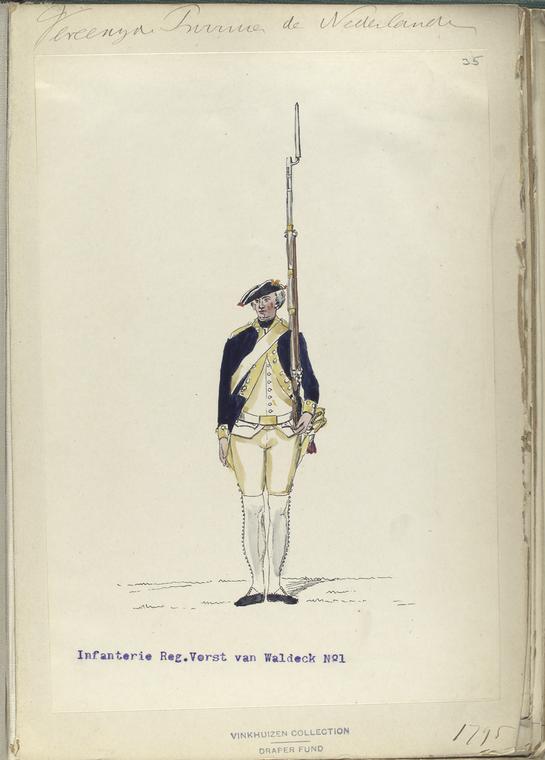

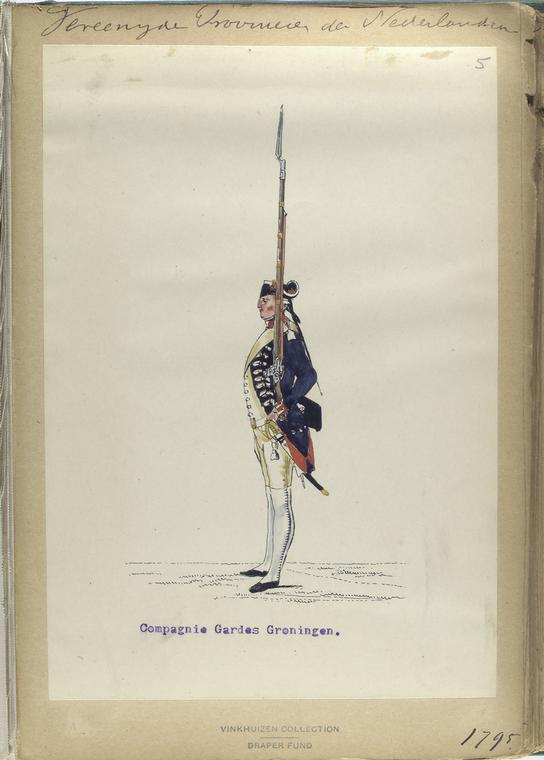











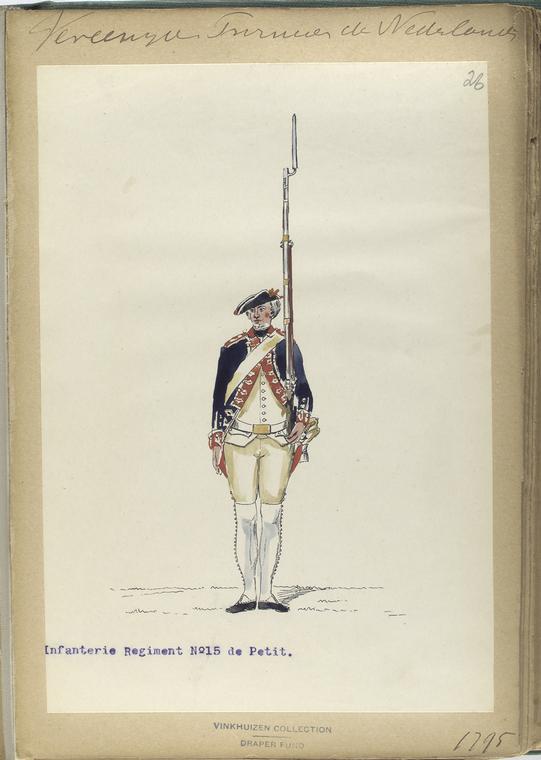















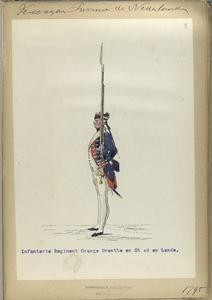












In the table, the Dutch names are used.
LIGHT UNITS










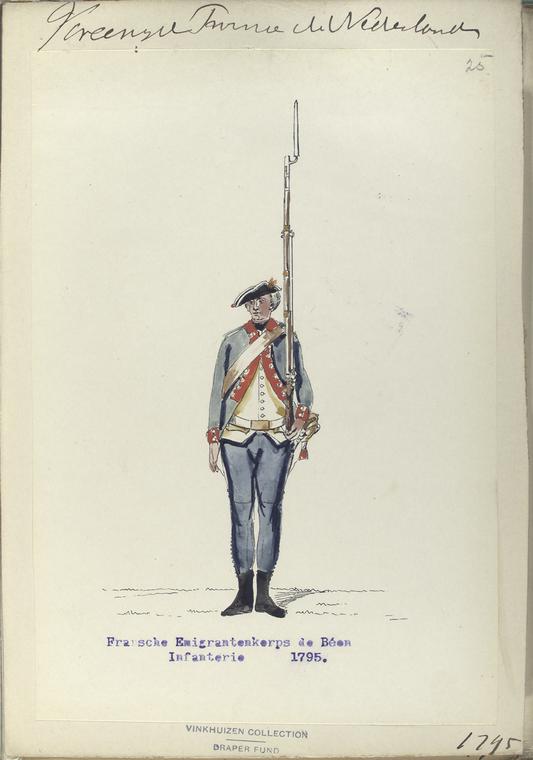
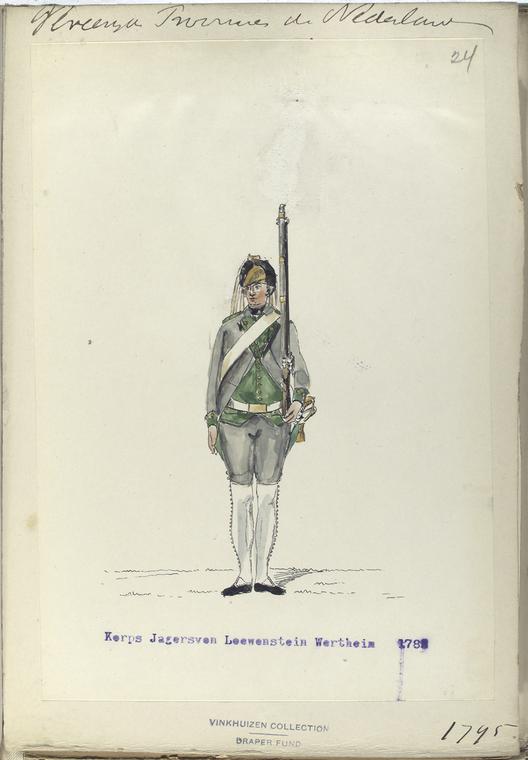






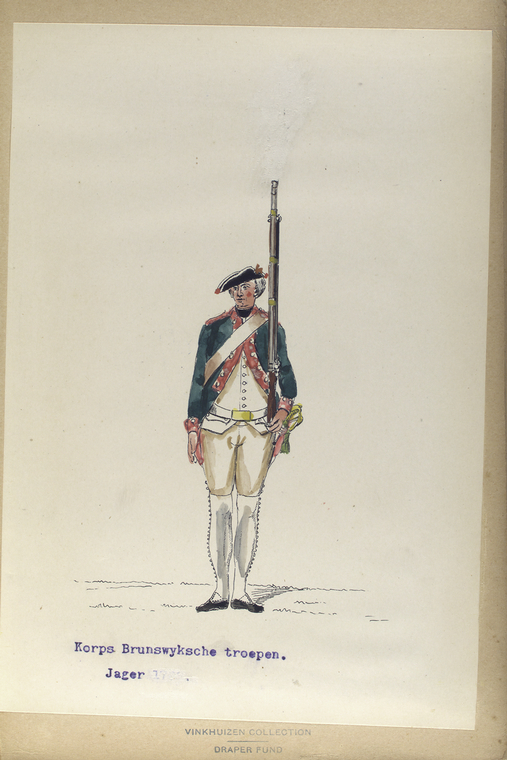


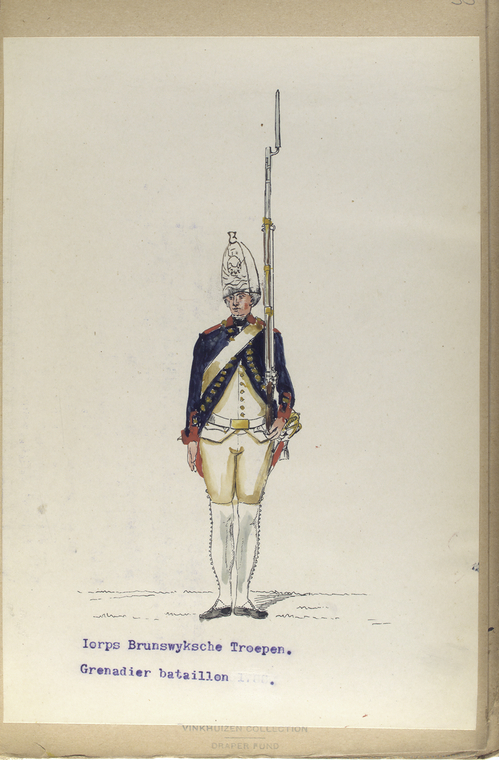






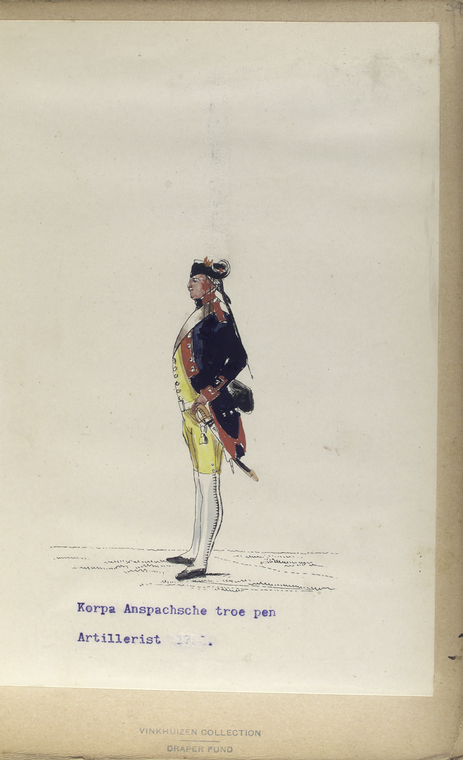





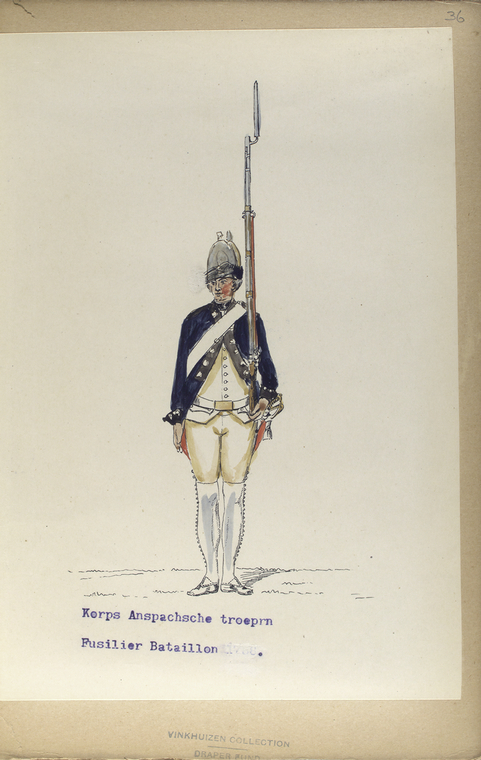








Campaigning
As said earlier, the theorical strength of the infantry wasn’t reached in reality. According to “Hardenberg” and “Kesman”, the 12 musketier companies of the infantry units which were meant to go to war in 1793, were combined into a field battalion of 8 companies and the grenadier companies were combined into seperate grenadier battalions of also 8 companies. Behind stayed a small depot per regiment.
In total 24 musketier battalions were formed with each 8 companies and added were 2 3pdr battalion guns per battalion (each gun with limber and 2 horses).
A list of musketier battalions for the 1793 campaign will be added later if available.
For the 1793 campaign grenadier companies were combined into battalions mostly of 8 companies from 4 regiments but sometimes only 6 companies of 3 (or 4) regiments and were called after their commanding officer. In the 1793 campaign “Kesman” gives the following organisation:
| name grenadier battalion | infantry regiment who delivered grenadier companies | |||
| Van Raesfeldt | Douglas | Van Maneil | Bentinck | desVilates |
| Von Buseck | Van Dopf | Van Brakel | De Thouars | Nassau Usingen |
| Van Breydenbach | Oranje Gelderland | Oranje Friesland | Oranje Stad en Lande en Drenthe | Van Plettenberg |
| van Zillnhardt | van Randwijk | 1e Waldeck | 2e Waldeck | Hessen-Darmstadt |
| Van Plettenberg | Bedaulx | van Welderen | Van Nijvenheim | De Schepper |
| van Tengnagell 13/9/1793 Prins van Reusz | Bosc de la Calmette | Von Wartensleben | Westerloo | van Baden |
| Van Rechteren (6 companies) | Stuart | Von Mönster | De Bons | |
| de Larrey (6 companies) | 1e Oranje Nassau | 2e Oranje Nassau (1 comp) | Erfprins | Markgraaf van Baden (1 comp) |
| van Hohenlohe (6 companies) | De Petit | Saxen-Gotha | von Wilcke |
For the 1794/95 campaign the infantry battalion had according to “F.H.A.Sabron: De oorlog van 1794/1795 op het grondgebied van de Republiek der Vereenigde Nederlanden” only 6 companies instead of the earlier mentioned 8 companies.
The regiments who delivered a field battalion in 1794 were Oranje Gelderland, Oranje Stad en Lande, 2nd Oranje Nassau, 1st Waldeck, Bedaulx, Von Dopf, Van Welderen, Von Wilcke, Hessen-Darmstadt, Van Maneil, Von Wartensleben, Bosc de la Calmette, De Petit and Van Plettenberg. All the Swiss regiments delivered 2 field battalions.
Also according to “Sabron”in the combined grenadiers had only 6 companies and originate from the following regiments
| name grenadier battalion | infantry regiment who delivered grenadier companies | ||
| Van Raesfeldt | Douglas | Van Maneil | Bentinck |
| Von Buseck | Van Dopf | Van Brakel | De Thouars |
| Van Dongen | Oranje Gelderland | Oranje Friesland | Oranje Stad en Lande en Drenthe |
| Mollenbruyn | Nassau-Usingen | Markgraaf van Baden | Van Plettenberg |
| Van Plettenberg | Bedaulx | Van Nijvenheim | De Schepper |
| Prins van Reusz | Von Geusau | Von Wartensleben | Westerloo |
| Prins van Hessen-Philipsthal | Van Welderen | Bosc de la Calmette | Des Vilattes |
| Van Panhuijs | Stuart | Von Mönster | De Bons |
| de Larrey 10/1/1794 Van Solms | Oranje Nassau 1e | Oranje Nassau 2e | Erfprins |
The strength of the infantry part of the army of the United Provinces in 1794 are given in “Sabron”” as:
| batt | name | per batt | total |
| line troops | |||
| 9 | grenadiers | 384 | 3.456 |
| 1 | Hollandse gardes | 504 | 504 |
| 1 | Zwitserse gardes | 504 | 504 |
| 14 | musketiers | 432 | 6.048 |
| 10 | Swiss | 510 | 5.100 |
| light troops | |||
| 1 | 5th Waldeck | 280 | 280 |
| 1 | Walen de Perez | 280 | 280 |
| 1 | Jagers van Bijlandt | 198 | 198 |
| 1 | Jagers van Matthieu | 277 | 277 |
| total | 16.647 |
The emigré units who took part at the start of the 1794 campaign were:
korps of Damas, total 250 men infantry
korps of Beon, total 494 men infantry
These totals were only the infantry part; both Damas and Beon had according to Sabron 2 companies dragoons with a total of 200 men for the 4 companies.
2.2.4 CAVALRY 1790-1795
Cavalry organisation and strength
The strength of the regiments given, are of course theoretical. The real strength was mostly far lower as is shown in the 1793 battelfield organisation where only part of each regiment was fit to go into the field; the rest formed a small depot (the same as for the infantry already mentioned).
The given strenght is based on H.Hardenberg: “Overzicht der voornaamste bepalingen betreffende de sterkte, zamenstelling, betaling, verzorging en verpleging van het Nederlandsche leger” (The Hague 1858).
In the table I have given the strength for the 1792 budget, the 1793 augmentatie (a) or reinformcements of beginning 1793 and the new 1793 strength. In the table are the strength of regimental staff and the various squadrons and companies of the regiment. Remember, these are theoretical.
Guard
In 1792 existed the Gardes du Corps of only one company, the Regiment Gardes te Paard of 4 squadrons and the Gardes Dragonders also of 4 sqadrons.
Line cavalry
In 1792 there were 6 cavalry regiments (for their names see in the uniform table) of 4 squadrons. Each squadron had 2 companies.
Dragoons
Besides the Gardes Dragonders, in 1792 existed 2 other regimenten dragonders but these had a strength of 8 squadrons each; each squadron had again 2 companies.
Hussars
In 1792 existed the regiment Huzaren van Heeckeren also called “zwarte huzaren” (black hussars) because of their black outfit. They were also called “Huzaren op Holland” because when in 1787 the Legion of the count of Salm was disbanded (to which the hussars belonged), they were kept in the service of the Province of Holland and were not in the pay of the United Provinces. On the budget of 1792 they became part of the army of the United Provinces.
There also existed the Huzaren Hoop or Roode Huzaren -red hussars- because of their red outfit.
I can’t find the regiment on the 1792 budget although it existed already in 1790. In 1794 they were called Huzaren van Timmerman after the death of its colonel Hoop.
1793 Augmentatie.
As with the infantry, also men were added to the cavalry regiments before the campaign of 1793..
The staff of each regiment received 3 men and to each company were added 18 men; so per regiment in total of 147men were added. The Guardes du Corps received an extra 9 men.
| staff | strength company | no. of sq | total no of comp | regimental strength | |||||||
| 1792 | a | 1793 | 1792 | a | 1793 | 1792 | a | 1793 | |||
| Guardes du Corps | – | – | – | 139 | 9 | 148 | – | 1 | 139 | 9 | 148 |
| Gardes te Paard | 8 | 3 | 11 | 43 | 18 | 61 | 4 | 8 | 352 | 147 | 499 |
| Cavalry regiment | 8 | 3 | 11 | 43 | 18 | 61 | 4 | 8 | 352 | 147 | 499 |
| Garde Dragonders | 8 | 3 | 11 | 43 | 18 | 61 | 4 | 8 | 352 | 147 | 499 |
| Dragonders | 8 | 3 | 11 | 43 | 18 | 61 | 4 | 8 | 352 | 147 | 499 |
| Huzaren Heeckeren | 7 | 3 | 10 | 43 | 18 | 61 | 4 | 8 | 351 | 147 | 498 |
Uniforms
In the presented table of regiments, the start date is 1772 as from that date onward, the regiments received numbers. This number was put on buttons etc although the regiments were still known after their owners’ name. The name with which the regiment is known is underlined. If in the table the first date is 01/01/1772, it means that the regiment existed before this date.
In 1795 the existing regiments or corps were reorganized (r) into units of the Batavian Republic or were disbanded (d). All guard and most “Orange” units were disbanded. Some German and Swiss units stayed in Dutch pay without any change and were later disbanded.
The cavalry of these years consisted of heavy cavalry (consisting of cavalerie and dragoons) and light cavalry (only hussars). Some cavalry units were added from the emigé units which were later raised (see 2.2.3). The army of the Dutch Republic had no cuirassiers.
In the presented table of regiments, the cavalry regiments listed are those which existed at the start of the revolutionary war (1792). The cavalry had no numbers but were called after their colonel.
As with the infantry mentioned earlier, in 1795 the existing regiments were reorganized (r) into units of the Batavian Republic or were disbanded (d). All guard units were disbanded.
In the table, the Dutch names are used. If the date raised is 1-1-1790, the regiment existed before this date















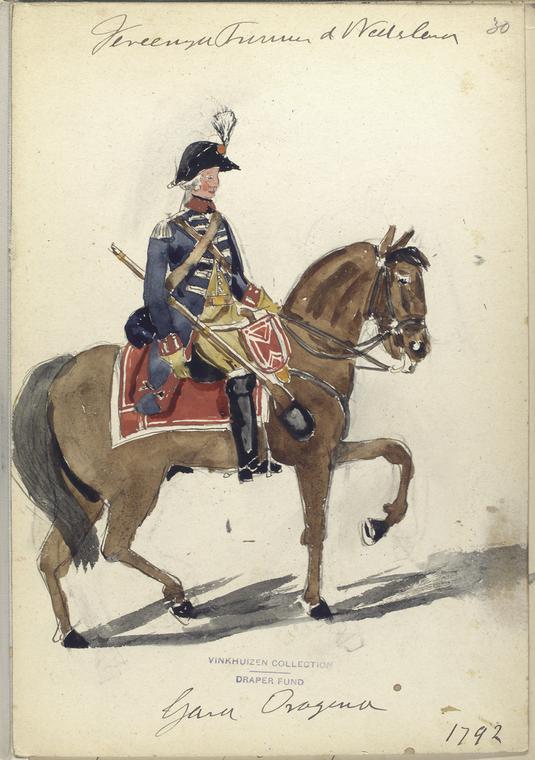








Campaigning
For the 1793 campaign each regiment delivered 2 squadrons to the field army, the rest of the regiment formed a weak depot.
According to F.H.A.Sabron for the campaing of 1794 the following cavalry strength was added to the field army of the United Provinces
| cavalry | Gardes te Paard | 2 sq. |
| Oranje Friesland | 2 sq. | |
| Van Tuyll | 2 sq. | |
| Bentinck | 2 sq. | |
| Hessen-Philipstall | 2 sq. | |
| van der Duijn | 2 sq. | |
| Hoeuft van Oijen | 2 sq. | |
| dragoons | Garde Dragonders | 2 sq. |
| Hessen-Cassel | 2 sq. | |
| Van Bylandt | 2 sq. | |
| Hussars | Van Heeckeren | 2 sq. |
| Timmerman | 2 sq. | |
| Emigré | Beon | 1 sq. |
| Damas | 1sq. |
The strength of the squadron can be put at this time at appr. 112 men while the emigre squadrons (each 2 companies) were smaller (appr 100 men) so the total cavalry arm counted 2.888 men.
2.2.5 ARTILLERY 1790-1795
Artillery organisation and strength
The artillery arm of the United Provinces consisted in 1792 only of foot artillery. For the campaign of 1793 4 companies horse artillery In in 2 brigades) were added.
Added to the artillery was a regiment of mineurs of 1 battalion of 4 companies with (in 1793) a total strength of 256 men. Also a company of pontoniers of 60 men belonged to the artillery arm.
According to the budget of 1792 the foot artillery consisted of a regiment foot artillery of 4 battalions each of 5 companies so a total of 20 companies. Each company had 137 men while the regimental staf had 15 men, so the regiment had a total of 2755 men.
With the augmentatie of 1793 an artillery staf was created of 5 men, each artillery company received 21 men or a total adding of 420 men to the 4 existing battalions. Each company now was 158men.
Added to the artillery was also:
– a fifth battalion with the same strenth as the other 4
– 4 companies of horse artillery (organised is 2 “brigades”) each company of 108 men. A small staff for the horse artillery brigades consisted of 7 men so the horse artillery total was 439 men (theoretical of course)
According to the “History of the horse artillery”in 1793 the horse artillery was raised to a strenth of 2 brigades each of 2 companies each of 6 officers, 7 NCO, 7 corporals , one trumpeter, 80 gunners and 5 workmen (smith, carpenter, wheelmaker etc) or a total of 106 men. There was no additional train personnel; theswe had to be rented in time of war..
Each company should have 4 6pdr, 2 3pdr and 2 24pd houwitzers.
Per gun, the crew consisted of:
6pdr: 1 NCO, 1 corporal, 7 gunners, 2 horse holders and 3 drivers (so the gun had a limber with 6 horses)
3prd: 1 NCO, 1 corporal, 7 gunners, 2 horse holders and 2 drivers (limber with 4 horses)
24pdr houwitzer: 1 NCO, 2 corporals, 6 gunners, 2 horse holders and 2 drivers (again limber with 4 horses)
Additional remark: horseholders and drivers were not mentioned in the organisation as mentioned in the budget. Of the 80 gunners of a company, 54 would be manning the guns according to the above organisation which leaves 26 gunners. The drivers and horse holders totals 36 so I think the 26 gunners were used as amunition carriers etc and drivers and horseholders were hired personnel. (but see the practice in the campaign under)
The mineurs and pontonniers received no extra men for the 1793 campaign.
Uniforms
In the table, the Dutch names are used.
Campaigning
For the 1793 campaign “Hardenberg” records that the artillery added tot the field army consisted of 48 3pdrs (for service with the field battalions – so grenadiers had no battalion guns- and 3 batteries of 6- and 12pounder guns and howitzers.
The field strenth of the artillery for the 1794 campaign was according to “Sabron” 20pieces of 12pound, 20 pieces of 6 pound, 2 howitzers of 16pound and 8 howitzers of 24 pound. How they were divided intot batteries I don’t know (yet).
The personel strength was 1766 men.
To give some more information about the Dutch horse artillery in the 1794 campaign (the practice of war!):
For the campaign of 1794, the horse artillery needed to be ready but was understrength and it was decided that one company (instead of the 4 mentioned) would be made ready. The first and second brigade needed to deliver both men for this company who had to be be mounted and armed.
Added to this, each brigade had to deliver 1 corporal and 10 men to act as drivers for the gun limbers. It is mentioned that this had to be expierenced men because manoeuvring the guns was difficult.
About the crews for caissons and other wagons is not spoken, so these had to be hired from sollicitors.
Additional note:
Mentioned is, that in the period of the Batavian Republic (after 1795) the manner in which the field train was formed stayed the same: men and horses for the train were hired in time of war. But this was changed for the horse artillery; although men and horses were hired, this was also during peacetime. This seperate arangement was changed in 1801 when permanent train personnel were added to the artillery; every artillery brigade received a train division; for each company 25 train servants and 25 horses.



